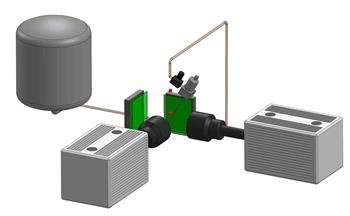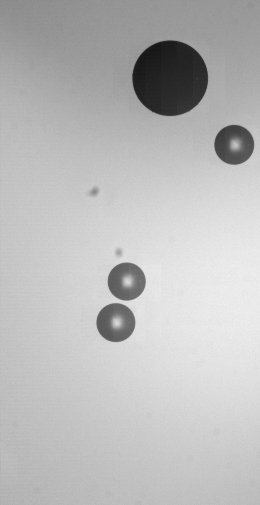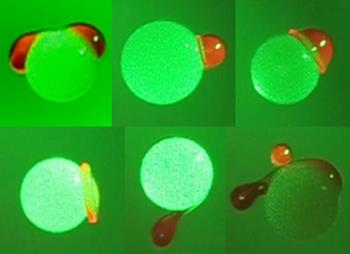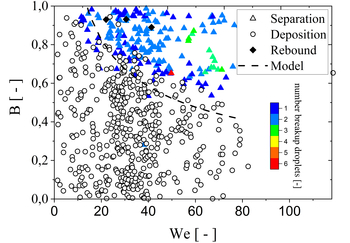Drop Particle
Ansprechpartner:
Lars Pasternak, Dipl.-Wirt.-Ing.
In this research project, based on experimental measurements, the fundamentals and theoretical models for the collision and coating of free movable solid particles with smaller droplets will be developed. These results represent the starting point for subsequent numerical calculations using an Euler/Lagrange approach. The decisive advantage of the experimental setup, see Fig. 1, which is especially designed for this research project, is that the drop-particle collisions are investigated under quasi-instationary condition. This implies that the droplets and the single particles can move without limitation and are only influenced by external forces, e.g. gravity.

By means of imaging measurement techniques, the collision of the single droplets (within the droplet chain) with the free-falling solid particle is performed at defined relative velocities and single droplet spacing and the collision outcome as result is determined. High-resolution high-speed cameras in combination with backlighting are used to detect the collision process over the collision sequence, see Fig. 2. In addition to the visualisation by continuous backlight LED arrays, pulsed laser and high-power LEDs are used for colour images, see Fig. 3. The unsteady trajectory of the falling particles requires an additional position-dependent particle detection system for automatic acquisition control of the high-speed cameras. The collision images are then processed by an open-source image analysis software, which is adapted to the requirements of the MPS working group. For all relevant influencing parameters, it is necessary to determine first the outcome of the collision and to summarize that outcome with the dimensionless numbers, e.g. through the connection with the Ohnesorge-number. The parameters that need to be examined are the size ratio (droplet/particle), droplet properties (viscosity, surface tension), relative velocity and the geometric parameters of the point of impact of the droplet on the particle. In the tests performed by the MPS working group, the droplets are smaller than the particles and the liquid is wetting. All these influences need to be taken into account when defining the collision regimes and developing appropriate physically based correlations from these data.
 |
 |
| Fig. 2: Collision sequence of a 1100 µm polystyrene particle with 570 µm maltodextrin dropletsFig. 2: Collision sequence of a 1100 µm polystyrene particle with 570 µm maltodextrin droplets | Fig. 3: Colored droplet-particle collision images, captured by using pulsed backlight LED. |
For the regime breakup, the size distribution of the generated fine droplets will be modelled, too. Subsequently, the collision results are summarized in a B-We diagram (Fig. 4), which represents the geometry of the collision and relative velocities of each the individual collision. The individual collision results are differentiated into rebouncing, deposition and breakup. As a final step, the deposited droplet volume as well as the liquid coating thickness on the particle, contact angle and the ration of coated particle surface are determined. For the development of the coating model, these variables are combined in dependence of the relevant dimensionless numbers and a correlation based on physical values will be developed. The developed models, which take into account a wide range of parameters, will be used for a Lagrangian calculation of technical coating processes.

Fig. 1: Sketch of the experimental set-up,; droplet generator with droplet chain, red: free-falling particle, HS-cameras, LED-Arrays, pressurised vessel.





